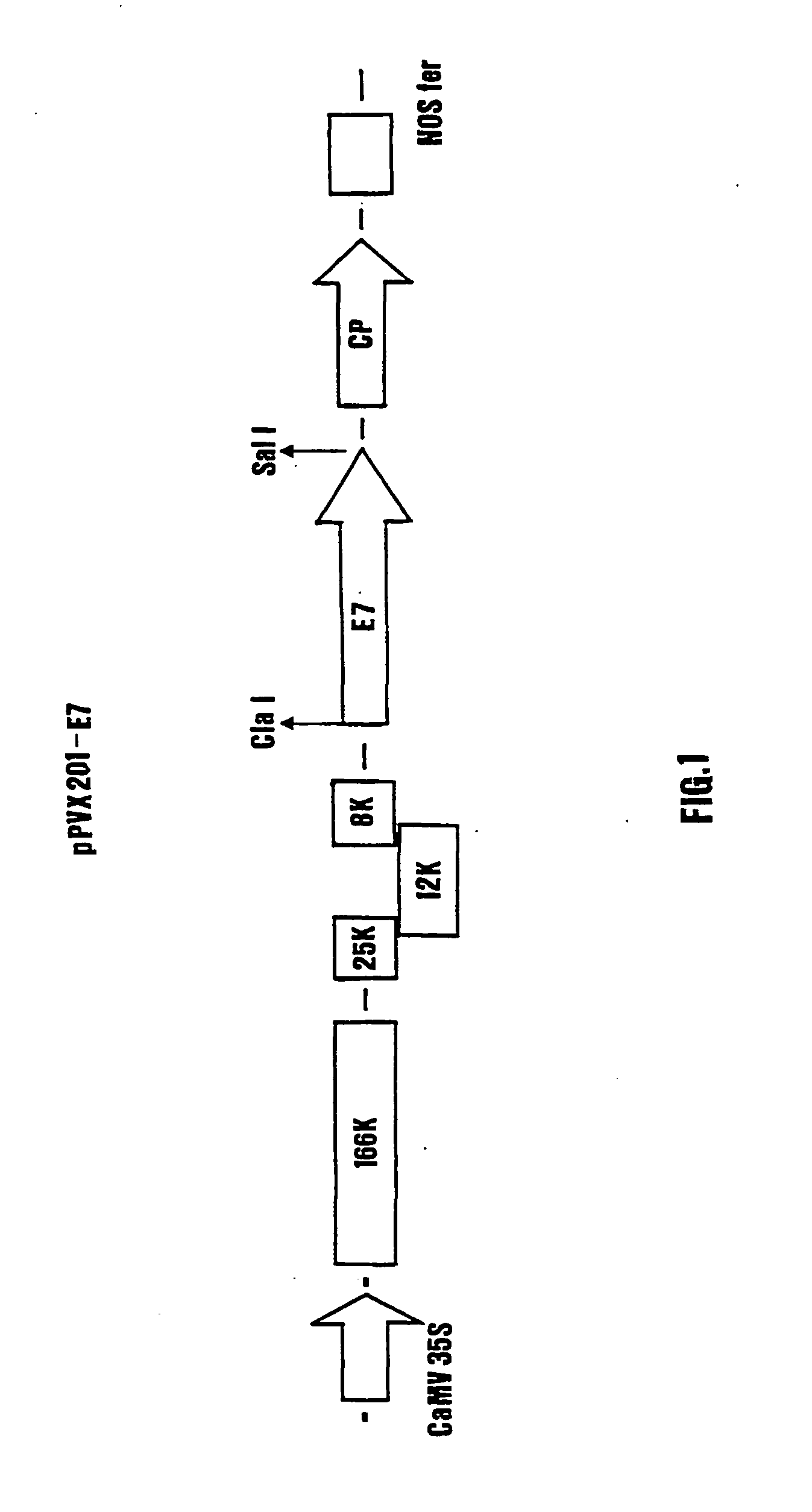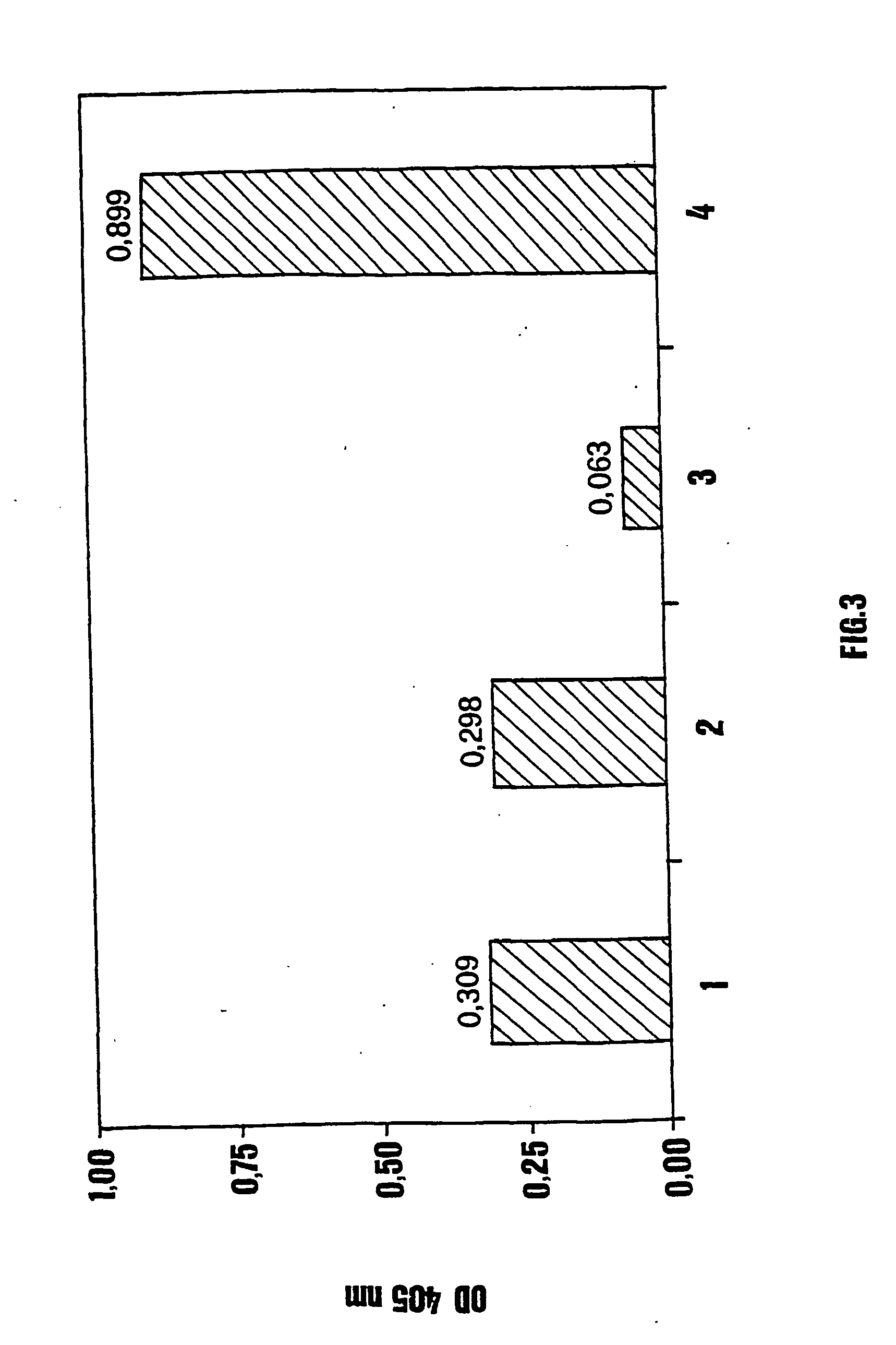Subunit vaccines and processes for the production thereof
a technology of subunit vaccines and vaccines, applied in the field of subunit vaccines, can solve the problems of low yield, toxicity of most subunit vaccines for routine clinical use, and low yield
- Summary
- Abstract
- Description
- Claims
- Application Information
AI Technical Summary
Benefits of technology
Problems solved by technology
Method used
Image
Examples
example 1
Construction of a Plasmid for the PVX-Mediated Expression
[0098] The HPV 16-E7 gene was amplified by PCR from the plasmid. E7-pGEX-4T1 (Di Lonardo A., Marcante M. L., Poggiali F., Venuti A. (1998). `HPV16 E7 antibody levels in cervical cancer patients: before and after treatment`. Journal of Medical Virology 54: 192-195) using as primers the oligonucleotides E7 For (5'GGC CAT CGA TTC TAG AC ATG CAT GGA GAT ACA CCT ACA CAT TG 3', sites for the enzymes Cla I and Xba I underlined, codon for Methionine bolded) and E7 Rev (5' GGC CGT CGA CCC C GGG TTA TGG TTT CTG AGA ACA GAT GGG 3', sites for the enzymes Sal I and Sma I underlined, STOP codon bolded).
[0099] After digestion with the restriction enzymes Cla I and Sal I, the fragment was cloned in the vector pPVX201, obtaining the plasmid pPVX201-E7, which allows soluble expression of the E7 protein upon manual infection with the DNA plasmid (FIG. 1).
[0100] After infection with DNA plasmid, N. benthamiana plants showing symptoms of infection...
example 2
Preparation of Plant Extract and Analysis of Expression of E7 Protein
[0101] E7 expression was analysed both by Western blot and ELISA. Plant soluble proteins were obtained by homogenization of leaves in a blender with liquid nitrogen. The resulting powder was resuspended (0.3 g of fresh leaf / ml buffer) in extraction buffer 1.times.PBS, containing protease, inhibitors (`Complete, EDTA-free`, Boehringer Mannheim). The extract was centrifuged 10 min at 12.000 g and supernatant collected. The proteins present in the plant extracts were separated by 12% SDS-PAGE and transferred by electroblotting onto PVDF filters. The presence of E7 protein was detected by using a mouse polyclonal serum obtained against the His-E7 purified from E. coli, diluted 1:1000, and subsequently a goat anti-mouse IgG conjugated with HRP. Reactions were developed with the ECL system. (Amersham) (FIG. 2).
[0102] PVX-E7 leaf extracts were used in order to determine the amount of total soluble protein (TSP) by using t...
example 3
Vaccine Composition made of a Plant Extract to which the Purified E7 Protein is Added
[0103] The E7-His protein produced from E. coli and purified according to standard procedures (PVX-WT+E7) was added to plant extracts deriving from N. benthamiana, infected with the PVX wild type (PVX-WT), prepared according to the procedures described in example 2.
[0104] Systemic leaves showing typical symptoms of infection were subjected to total protein extraction in PBS buffer with and without protease inhibitors, according to the process described in example 2.
[0105] For a better characterisation, the foliar extracts of PVX-WT N. benthamiana, to which the purified His-E7 protein had been added from the outside at a final concentration of 8.3 ng / .mu.l (PVX-WT+E7) in the extract, were kept at room temperature and at +4.degree. C. for 2 hours prior to analysis by Western blot and ELISA.
[0106] The results of the Western blot performed comparing the PVX-WT+E7 and the PVX-E7 extracts highlight the in...
PUM
| Property | Measurement | Unit |
|---|---|---|
| Concentration | aaaaa | aaaaa |
| Solubility (mass) | aaaaa | aaaaa |
| Immunogenicity | aaaaa | aaaaa |
Abstract
Description
Claims
Application Information
 Login to view more
Login to view more - R&D Engineer
- R&D Manager
- IP Professional
- Industry Leading Data Capabilities
- Powerful AI technology
- Patent DNA Extraction
Browse by: Latest US Patents, China's latest patents, Technical Efficacy Thesaurus, Application Domain, Technology Topic.
© 2024 PatSnap. All rights reserved.Legal|Privacy policy|Modern Slavery Act Transparency Statement|Sitemap



